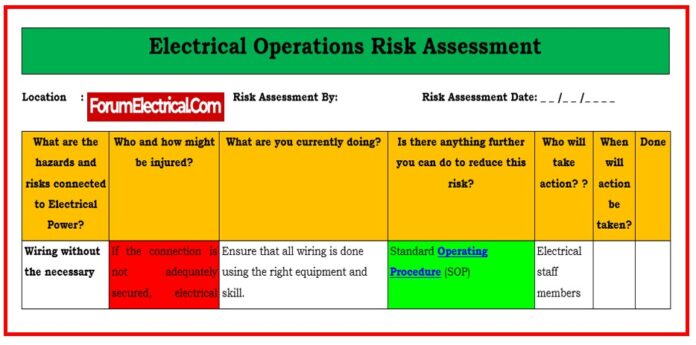What is an Electrical Risk Assessment?
The risk assessment should include factors such as the nature of the electrical equipment utilized, its operational procedure, and the surrounding environment. It is the responsibility to ensure that the electrical installation as well as equipment are appropriate for both their designated purpose and the operating conditions.
Electrical Safety at Work
Electrical safety in the workplace is essential to human life and operations. Important reasons to prioritize electrical safety:
- Electrical failures can damage, kill, or permanently harm workers.
- Electrical accidents harm equipment and interfere with productivity.
- Safety standards & regulations are essential for employee welfare and often required by legislation.
- Safety improves reputation among employees, consumers, and stakeholders.
- Accidents result in medical bills, equipment repairs, and legal obligations.
Electrical Risk Assessment Objectives
Objectives of electrical risk assessments include:
- Systematic assessment of workplace electrical dangers.
- Relating hazards to severity.
- Reducing accidents and dangers through controls & safety measures.
- Follow regulatory and industry guidelines.
- Monitoring and improving safety protocols.
- Risk evaluations help manage and reduce electrical system and equipment risks, making the workplace safer.
Framework for Law and Regulations
NFPA 70E (National Fire Protection Association) Guidelines
The “Standard for Electrical Safety in the Workplace” (NFPA 70E) was created in the US by the National Fire Protection Association (NFPA). It functions as a thorough document providing standards for electrical hazard safety in the workplace.
OSHA (Occupational Safety and Health Administration) Standards
Ex: AS/NZS 3000: Electrical systems, including building wiring & switchboards, for electrical safety (Australia/New Zealand Wiring Rule)
Steps for Risk Assessment
- Determine any electrical risks related to the work, the electrical system, (or) the electrical process that is involved (such as the danger of shock or arc flash).
- Determine the electrical work that has to be done on the electrical system (or) procedure.
- Describe the various damage and failure conditions that could expose people to electrical risks.
- Evaluate the extent of the possible harm caused by the electrical risks.
- Find out the probability of each hazard occurrence.
- Specify the danger connected with the given hazard.
- Determine what further precautions or corrective activities need to be done if the risk level is unacceptable.
Our electrical experts have thoroughly evaluated and analyzed electrical risk assessments from an array of organizations. Their practical views have been compiled into detailed tables that provide insightful perspectives on practical applications.
It is possible to understand the risk associated with a recognized hazard as consisting of the probability of the damage occurring as well as its degree of severity.
Attachment
Summary
The workplace electrical safety is essential to both employee protection and company sustainability. Through comprehension and resolution of the underlying causes of electrical hazards, industries can drastically lower risks and establish a safer atmosphere.
Workplaces can considerably lower the risks connected with electrical systems, protecting employee health and safety, and creating a secure working environment by understanding the elements that lead to electrical hazards, regularly conducting risk assessments, & cultivating a safety-oriented environment.









